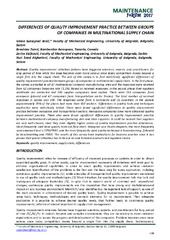| dc.creator | Spasojević Brkić, Vesna | |
| dc.creator | Tomić, Branislav | |
| dc.creator | Veljković, Zorica | |
| dc.creator | Algheriani, Nuri Mohamed Saad | |
| dc.date.accessioned | 2023-02-01T12:24:26Z | |
| dc.date.available | 2023-02-01T12:24:26Z | |
| dc.date.issued | 2017 | |
| dc.identifier.uri | https://machinery.mas.bg.ac.rs/handle/123456789/4134 | |
| dc.description.abstract | Quality improvement initiatives failures have triggered scientists, experts, and practitioners for
long period of time while this issue becomes even more serious since today competition moves beyond a single firm into the supply chain. The aim of this survey is to find statistically significant differences of quality improvement practice between groups of companies in multinational supply chain. In the first phase, the survey is emailed to all 87 multinational company manufacturing sites and the responses were received from 62 companies (response rate 71.3%). Based on received responses, in the second phase their suppliers worldwide are contacted and 143 supplier companies have replied. There were 153 companies from aerospace (planes) and 47 companies from transportation sector (trains). The total number of received responses in survey was 200. The responses came from 6 continents and 32 countries. In the sample approximately 70% of the plants had more than 500 workers. Differences in quality tools and techniques application were statistically tested. There were found significant differences in quality improvement
practice between aerospace and transportation sectors. Aerospace companies have more advanced quality improvement practice. There also were found significant differences in quality improvement practice between multinational company manufacturing sites and their suppliers. It could be noticed that suppliers are very well chosen, since they have slightly higher values of quality improvement practice dimensions. Most frequently used basic quality tools are flow chart, histogram and Pareto diagram; the most frequently used advanced tool is CPM/PERT, and the most frequently used quality technique is brainstorming, followed by benchmarking and FMEA. The results of this survey have implications for business practice since it has proven that special attention has to be put on core business products and suppliers choice. | sr |
| dc.language.iso | en | sr |
| dc.rights | openAccess | sr |
| dc.rights.uri | https://creativecommons.org/licenses/by/4.0/ | |
| dc.source | Maintenance forum 2017 | sr |
| dc.subject | quality improvement | sr |
| dc.subject | supply chain | sr |
| dc.subject | differences | sr |
| dc.title | Differences of Quality Improvement Practice Between Groups of Companies in Multinational Supply Chain | sr |
| dc.type | conferenceObject | sr |
| dc.rights.license | BY | sr |
| dc.citation.volume | 1 (1) | |
| dc.identifier.fulltext | http://machinery.mas.bg.ac.rs/bitstream/id/9472/Maintenance2017198-203V_Spasojevic_Brkic-2-7.pdf | |
| dc.identifier.rcub | https://hdl.handle.net/21.15107/rcub_machinery_4134 | |
| dc.type.version | publishedVersion | sr |


